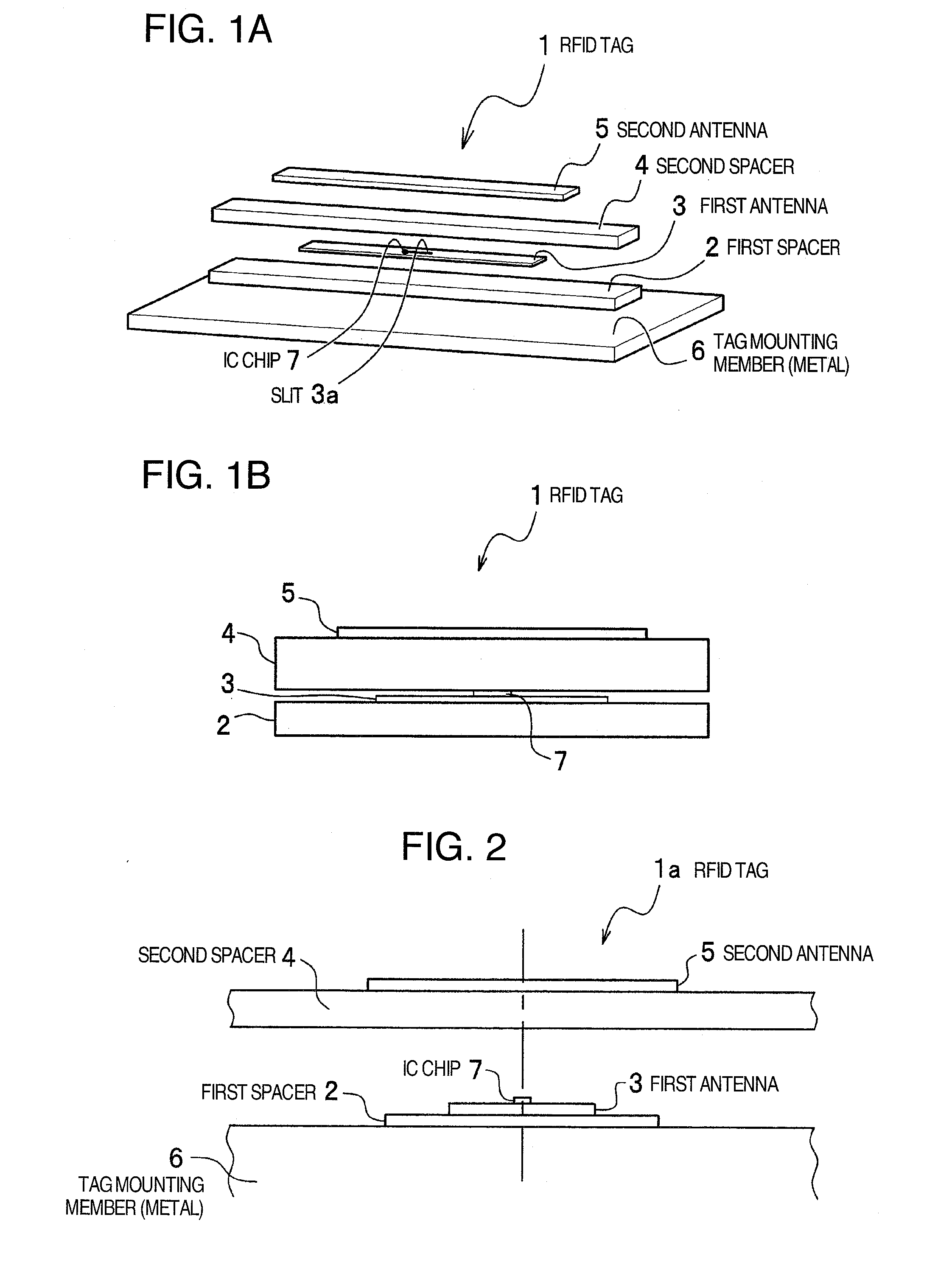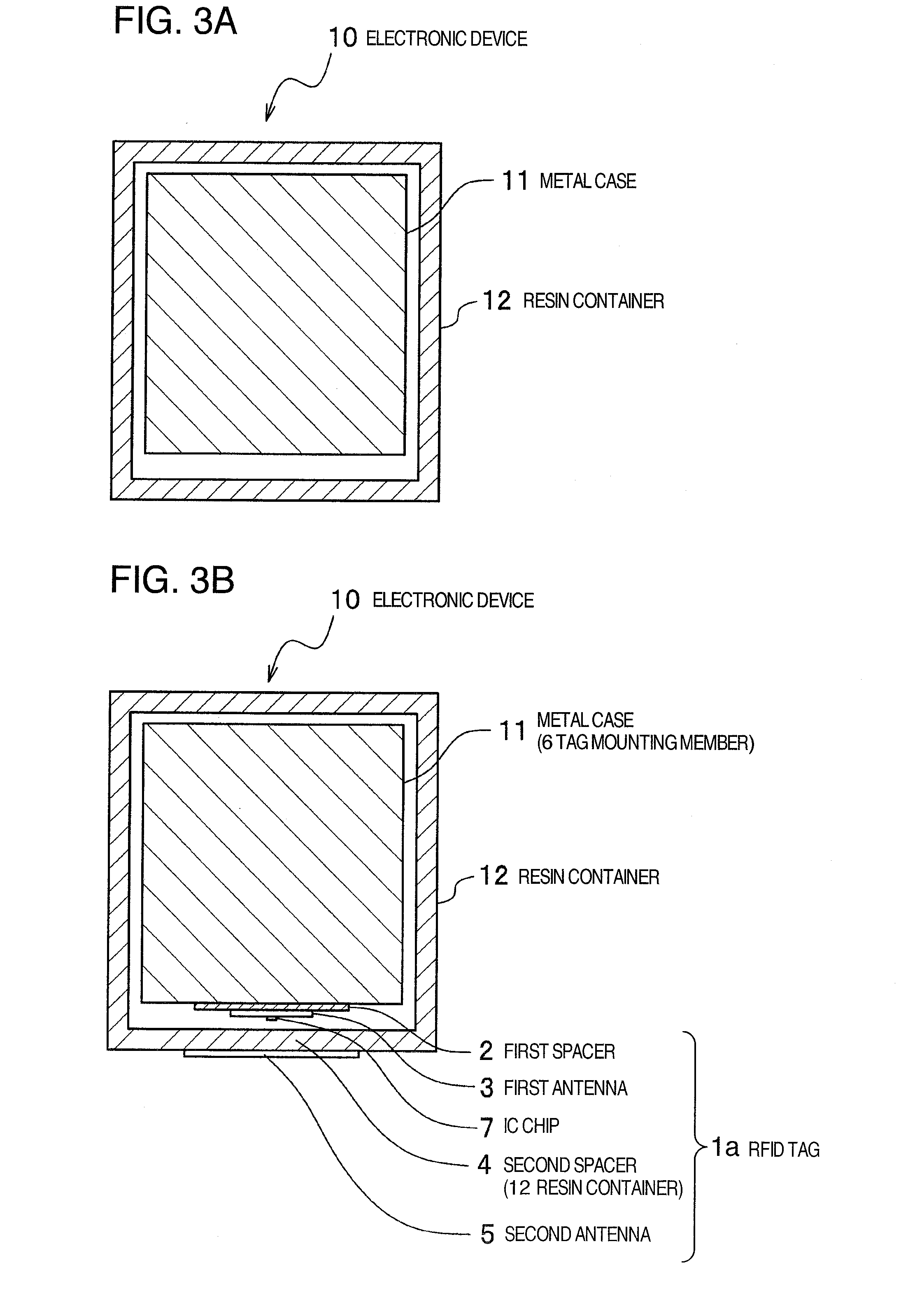RFID tag and method for reading the same
a technology of rfid tags and rfid tags, which is applied in the field of rfid (radio frequency identification) tags, can solve the problems of rfid tags coming off by mistake, and it is fairly difficult to place laminated rfid tags through the intermediary of the first spacer in a narrow clearance between the surface of the metal case and the resin container, so as to reduce the variation in the quality of rfid tag products, and the effect of downsiz
- Summary
- Abstract
- Description
- Claims
- Application Information
AI Technical Summary
Benefits of technology
Problems solved by technology
Method used
Image
Examples
first embodiment
[0029]FIGS. 1A and 1B are block diagrams showing an RFID tag 1 according to a first embodiment of the present invention, in which FIG. 1A shows the state when the component elements are taken apart, and FIG. 1B shows the state when the component elements are stacked.
[0030]As will be described later with reference to FIGS. 3A and 3B, in an electronic device 10 structured to house a metal case 11 with an electronic circuitry accommodated therein in a resin container 12, a RFID tag 1a is formed in a thin structure suitable for its mounting by using a narrow clearance between the outer surface of the metal case 11 and the inner surface of the resin container 12. The resin container 12 is made of a synthetic resin in this case, but may be made of any other nonconductive material, such as a hard rubber or dried wood. The metal case 11 is formed of a metal such as aluminum or copper and used to perform electromagnetic shielding inside and outside of the metal case. The RFID tag 1a in this ...
second embodiment
[0066]FIG. 11 is a transparent plan view of an electronic device 10 including an RFID tag 1b according to a second embodiment of the present invention.
[0067]An RFID tag 1b according to the second embodiment can be mounted appropriately when the clearance between the metal case 11 and the resin container 12 in an electronic device 10 is a little wider. In other words, the first spacer 2 and the first antenna 3 are attached to the outer surface of the metal case 11 with an adhesive, and furthermore the second antenna 5 is attached to the inner surface of the resin container 12 at a position thereof facing the first antenna 3. In this case, the space between the first antenna 3 and the second antenna 5 serves as the second spacer 4. In other words, the air with a relative permittivity of 1 acts as the second spacer 4, but since the communication distance of the first antenna 3 is enough for waves to reach the second antenna 5, high-intensity electric waves can be radiated from the seco...
third embodiment
[0068]FIG. 12 is a transparent plan view of an electronic device 10 including an RFID tag 1c according to a third embodiment of the present invention.
[0069]In the RFID tag 1c according to the third embodiment, the first antenna 3 is attached directly to the inner surface of the resin container 12 without any intermediary, such as the first spacer 2 (refer to FIG. 3). And, the second antenna 5 is attached to the outer surface of the resin container 12 at a position thereof facing the first antenna 3.
[0070]According to the RFID tag 1c of the third embodiment, the RFID tag 1c can be mounted even when the clearance between the metal case 11 and the resin container 12 is narrow.
[0071]As has been described, an RFID tag according to the present invention includes a first antenna 3 on which an IC chip is mounted and a second antenna 5 that resonates at a prescribed frequency with the first antenna 3, and the first antenna 3 and the second antenna 5 are structured so as to be separated from ...
PUM
 Login to View More
Login to View More Abstract
Description
Claims
Application Information
 Login to View More
Login to View More - R&D
- Intellectual Property
- Life Sciences
- Materials
- Tech Scout
- Unparalleled Data Quality
- Higher Quality Content
- 60% Fewer Hallucinations
Browse by: Latest US Patents, China's latest patents, Technical Efficacy Thesaurus, Application Domain, Technology Topic, Popular Technical Reports.
© 2025 PatSnap. All rights reserved.Legal|Privacy policy|Modern Slavery Act Transparency Statement|Sitemap|About US| Contact US: help@patsnap.com



